Rebirth of Le Corbusier’s
Salvation Army Building
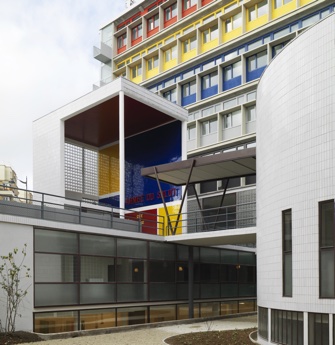
The Cité de Refuge. © FLC/ADAGP/Cyrille Weiner
The residents of the Cité de Refuge in Paris count themselves lucky indeed. Not only do they live in a historic monument designed by one of the 20th century’s greatest architects, Le Corbusier (Charles Edouard Jeanneret) and his cousin, Pierre Jeanneret, but some of their studio apartments are bigger, brighter and better-equipped than those of many of my professional friends in this city with increasingly out-of-reach real-estate prices.
The Cité de Refuge was built by the Salvation Army (Armée du Salut in French) and opened in 1933 on what was then the outskirts of Paris so that the delicate sensibilities of the city’s inhabitants wouldn’t be disturbed by having to mix with the building’s impoverished residents. Ironically, the city has grown up around it, and the Cité is now hemmed in by the mostly banal high rises of the Rive Gauche development area around the Bibliothèque
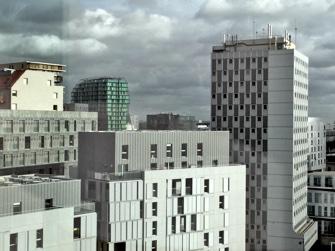
The skyline around the Cité de Refuge. The green building, designed by Maison Edouard François and nicknamed the “Vertical Chameleon,” will be covered in vegetation.
Nationale de France in the 13th arrondissement. By some miracle, 80 years after it was built it has not been converted into a luxury hotel but is still owned by the Salvation Army and still provides help and a home for the down and out.
What’s new is that the building, which was in a pitiable state, has just been restored as closely as possible to the way Le Corbusier intended it
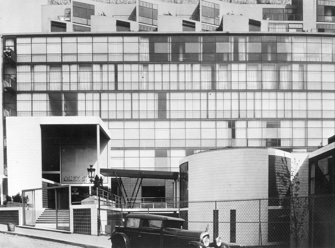
Above: the Cité de Refuge in 1933; below, in 1952. © FLC/ADAGP
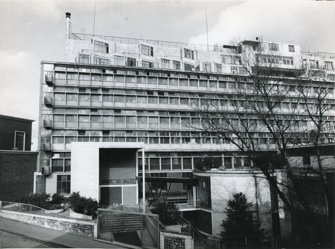
by François Chatillon, chief architect for Historical Monuments, and François Gruson of the agency Opéra, who had the unusual task of working on a 20th-century masterpiece rather than a centuries’ old château or monument and meeting such complex challenges as trying to figure out exactly what colors Le Corbusier and Jeanneret intended for the building. This was not the building’s first restoration, and trying to decide what was original and what was not made the job more difficult. In the end, some changes were left in place. “It’s a palimpsest,” said Gruson during a visit to the renovated building.
Many features of the original building were rediscovered when walls that had been added over the years were knocked down, opening up
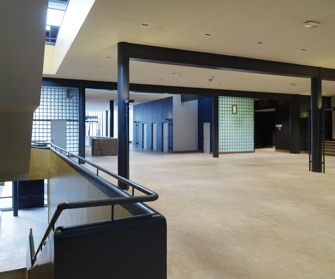
The main hall today. © FLC/ADAGP/Cyrille Weiner
generous spaces and revealing such thoughtful details as a small terrace with a light- colored wall positioned to reflect light into the room on a gloomy day.
Some changes were necessitated by evolving laws and standards. While the residents once slept in dormitories, they are now housed in rooms or studios, and the buildings (an extension, the Centre Espoir, built in 1978, has also been renovated) are now accessible to the disabled.
Since the mission of the Salvation Army is not only to provide a bed and nourishment to the needy but also to help reintegrate them into society, the building, which is pretty much self-sufficient, has its own kitchen, dining room, rooftop terrace/garden, classrooms, workshops, laundry, library and gym.
One may well wonder why such an avant-garde architect was chosen for this project. Therein lies the tale of the Princesse de Polignac, née Winnaretta Singer, who contributed one-third of the cost of the building and dictated the choice of architect.
A colorful character who lived in Paris and hosted performances of works by the greats of the music world in her salon, among them Debussy, Fauré, and Ravel (Marcel Proust, who was a frequent guest – along with Isadora Duncan, Jean Cocteau, Claude Monet, Serge Diaghilev and Colette – drew on the princess’s salon and the music he heard there for his novel), she had made it clear to her first husband that she was not interested in sex with men by jumping onto an armoire on their wedding night and threatening to kill him if he came near her.
Her marriage to her second husband, the Prince Edmond de Polignac, was more felicitous. He was gay, she was a lesbian, and they were great friends, making for the perfect mariage de raison.
The princess’s sympathy for the disinherited was such that she had a room built for herself in the Cité de Refuge because she wanted to die there among the poor. In the end, it was not fated to happen, but the good news for tourists is that her modest studio is still there and will soon be available for short-term rentals. Not bad: a princess’s room in a building by Le Corbusier. Now that’s something to put on your postcards.
Guided tours by residents will eventually be available. For those who wish to know more about the social and architectural history of the building, the book La Cité de Refuge: Le Corbusier et Pierre Jeanneret, L’Usine à Guérir (available in French only) by Olivier Chadoin and Gilles Ragot will be published in March by Les Éditions du Patrimoine.
La Cité de Refuge: 12 Rue Cantagrel, 75013 Paris. Métro: Bibliothèque-François Mitterrand. Tel.: 01 53 61 82 00.
Reader reaction: Click here to respond to this article (your response may be published on this page and is subject to editing).
Please support Paris Update by ordering books from Paris Update’s Amazon store at no extra cost. Click on your preferred Amazon location: U.K., France, U.S.
More reviews of Paris art shows.
© 2016 Paris Update
Favorite